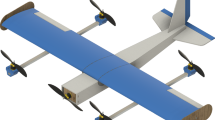Abstract
Electromechanical actuators (EMAs) are increasingly being used in aircrafts under the More Electric Aircraft initiatives. New satellite launch vehicles are being configured with EMA for the thrust vector control and mixture ratio control systems. Analysis of failure modes and their effects in the design stage of a new system is an essential exercise to be done for safety–critical applications of aircraft and human-rated launch vehicle. The thrust vector control system used in the terminal stage of a satellite launch vehicle which does not have any fault tolerance, referred hereafter as no redundancy actuator (NRA), is considered for the case study. At first, a thorough study is conducted on the failures encountered in the NRA and the corrective actions to be taken to avoid these failures in the new design are identified. Improvement in fault tolerance is attempted in two phases. In the first phase, the redundancy features are incorporated in the electrical systems of the actuator such as electric motors and sensors which form part of the closed loop system, leading to the electrical redundancy actuator (ERA). The next logical step is to use a high redundancy actuator (HRA) having fault tolerance to stuck and loose failures in its moving elements such as ball bearings, ball screws and motors. In this paper, failure mode and effects analysis (FMEA) of the existing and the two proposed configurations is carried out. The HRA is designed following the failure mode avoidance technique through four strategies, which are relaxing a constraint limit, using physics of incipient failure, having different operating modes and exploiting dependencies among failure modes. It is concluded that the HRA configuration eliminates a number of single failure points present in NRA and ERA, and it is found to have a better fault tolerance to the failures in its electrical and mechanical elements.




















Similar content being viewed by others
References
Guan Qiao, Geng Liu, Zhenghong Shi, Yawen Wang, Shangjun Ma, Teik C Lim, A review of electromechanical actuators for More/All Electric aircraft systems. J Mech Eng Sci 232(22), 4128–4151 (2018)
M.D.L. Dalla Vedova, D. Lauria, P. Maggiore, L. Pace, Electromechanical actuators affected by multiple failures: a simulated-annealing-based fault identification algorithm. Int J Mech 10, 219–226 (2016)
D. Belmonte, M.D.L. Dalla Vedova, C. Ferro, P. Maggiore, Electromechanical actuators affected by multiple failures: prognostic method based on spectral analysis techniques, in Klimis Ntalianis, (Ed.), AIP Conference Proceedings, Vol. 1836 (Rome), pp. 020020-1–020020-6 (2017)
C. S. Byington, P.E. Paul Stoelting, A Model-Based Approach to Prognostics and Health Management for Flight Control Actuators, IEEE Aerospace Conference Proceedings, Vol. 6, 2004 (Montana), pp. 3551-3562
E. Balaban, A. Saxena, P. Bansal, K. F. Goebal, P. Stoelting, S. Curran, A Diagnostic Approach for Electro-Mechanical Actuators in Aerospace Systems, IEEE Aerospace Conference, 2009 (Montana), pp. 1–13
A. G. Ricardo de Arriba, Health and Usage Monitoring System (HUMS) Strategy to enhance the Maintainability & Flight Safety in a Flight Control Electromechanical Actuator (EMA). Third European Conference of the prognostics and health management society, Vol. 7, 2016 (Bilbao)
M. Mazzoleni, Y. Maccarana, F. Previdi, G. Pispola, M. Nardi, F. Perni, S. Toro, Development of a reliable electro-mechanical actuator for primary control surfaces in small aircrafts, International conference on advanced intelligent mechatronics, 2017 (Munich), pp. 1142–1147
A. Baklouti, N. Nguyen, F. Mhenni, J.-Y. Choley, Improved Safety Analysis Integration in a Systems Engineering Approach. J Appl Sci 9, 1246 (2019)
N. H. J. Yao, S. Li, Accelerated Life Test and Life Prediction of an Electromechanical Actuator, in International conference on artificial intelligence and advanced manufacturing, 2019 (Dublin), pp. 647–651
R. Grepl, M. Matejasko, M. Bastl, F. Zouhar, Design of a Fault Tolerant Redundant Control for Electro Mechanical Drive System, Proceedings of the 21st International conference on automation & computing, 2015 (Glasgow), pp. 1–6
S. Zhu, T. Cox, Z. Xu, C. Gerada, C. Li, Design Considerations of Fault-Tolerant Electromechanical Actuator Systems for More Electric Aircraft (MEA). IEEE Energy conversion congress and exposition, 2018 (Portland), pp. 4607–4613
Don Clausing, Daniel D. Frey, Improving System Reliability by Failure-Mode Avoidance Including Four Concept Design Strategies. Syst Eng 8(3), 245–261 (2005)
E. L Morse, J. R Fragola, B. Putney, Modeling launch vehicle reliability growth as defect elimination, in AIAA Space 2010 conference and exposition, 2010 (California)
X. Du, R. Dixon, R.M. Goodall, A.C. Zolotas, Modeling and control of a high redundancy actuator. Mechatronics 20(1), 102–112 (2010)
B. Biju Prasad, N. Biju, M.R. Radhakrishna Panicker, High redundancy electromechanical actuator for thrust vector control of a launch vehicle. Aircraft Eng Aerosp Technol 91(8), 1122–1132 (2019)
European Cooperation for Space Standardization (ECSS-Q-ST-30-02C): Space product assurance - Failure modes, effects (and criticality) analysis (FMEA/FMECA), ESA Requirements and Standardization Division, The Netherlands
Acknowledgment
The authors wish to thank Director, VSSC, for the constant encouragement for advancement in the field of electromechanical actuation systems and permitting to publish the paper. The author gratefully acknowledges the critical review and comments on the paper by Mr. K.C. Reghunatha Pillai of Vikram Sarabhai Space Centre.
Author information
Authors and Affiliations
Corresponding author
Additional information
Publisher's Note
Springer Nature remains neutral with regard to jurisdictional claims in published maps and institutional affiliations.
Rights and permissions
About this article
Cite this article
Biju Prasad, B., Biju, N., Radhakrishna Panicker, M.R. et al. Failure Mode Investigation and Redundancy Management of an Electromechanical Control Actuator for Launch Vehicle Application. J Fail. Anal. and Preven. 20, 1644–1660 (2020). https://doi.org/10.1007/s11668-020-00967-x
Received:
Published:
Issue Date:
DOI: https://doi.org/10.1007/s11668-020-00967-x




